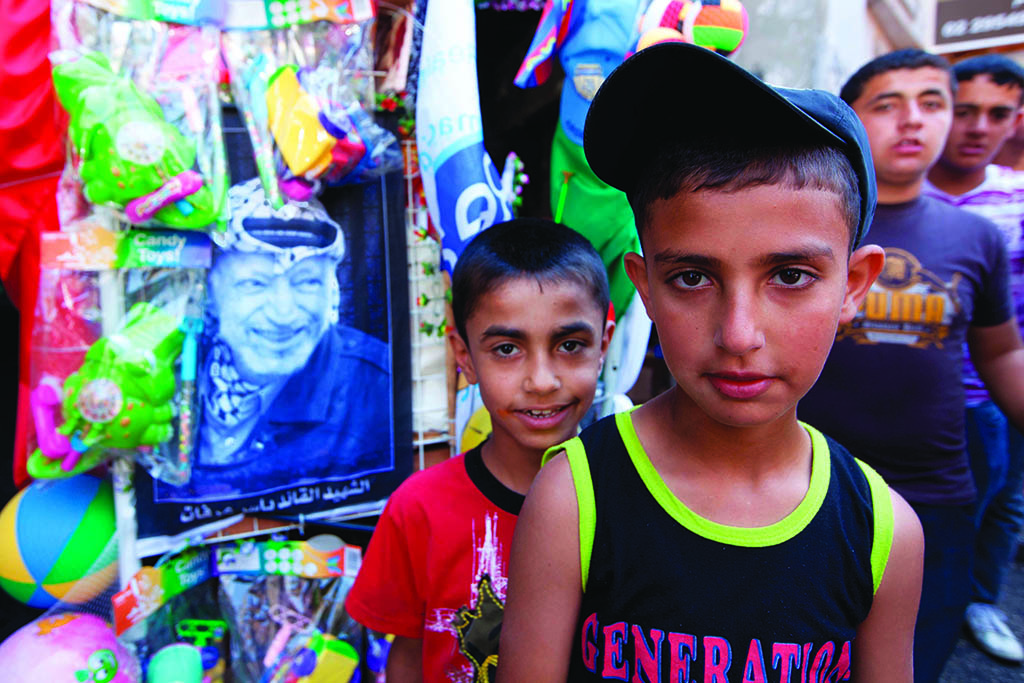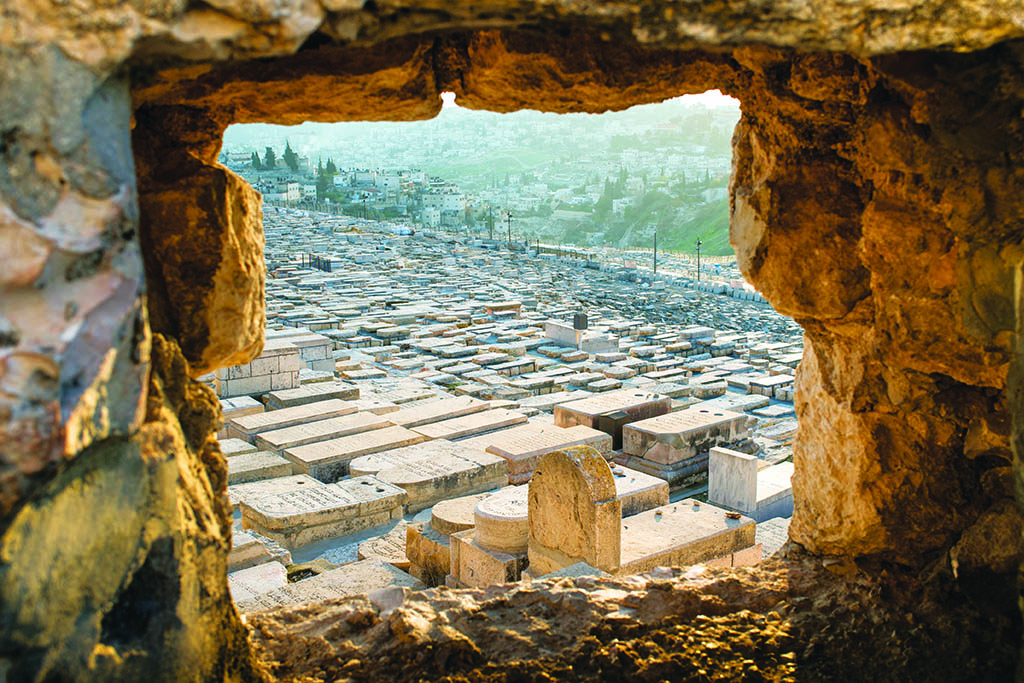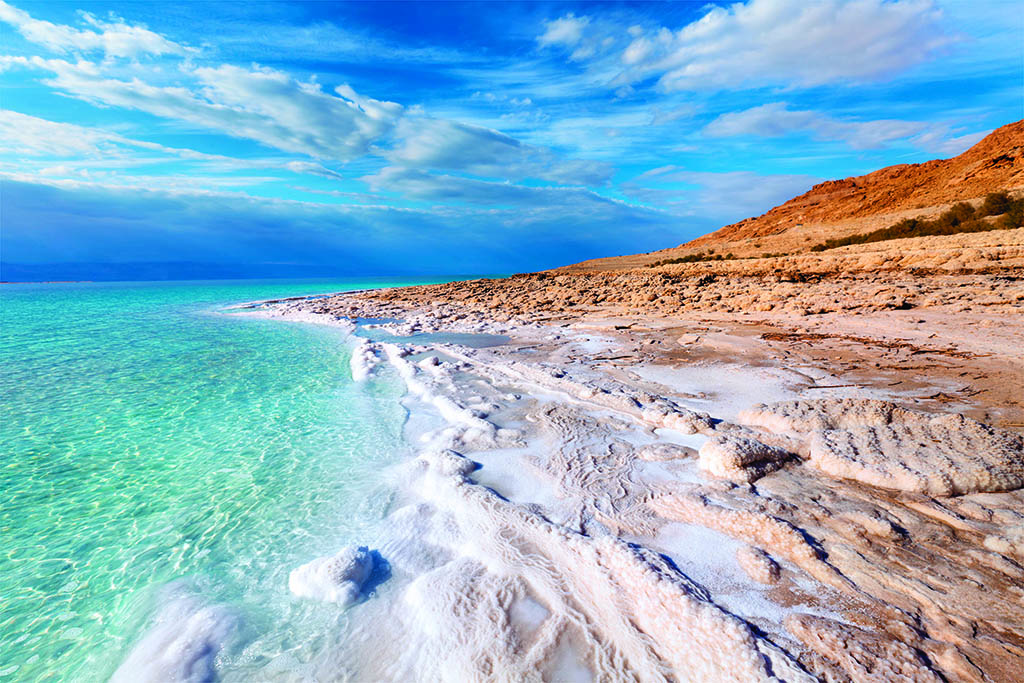“Meet me at Arafat Square,” my gay Palestinian friend Najeeb texted me, “I’ll take you to one of the queer cafés in Ramallah.”
Not knowing how to say “square” in Arabic, my taxi ended up taking me to Arafat’s Tomb—an iron gate, guarded by Palestinian Authority officers with big guns. It was 1 A.M. No Najeeb. No phone credit. No cabs passing by. Then, one of the guards started walking toward me, and I felt a nervous sweat trickle down my back. I saw him reach for me and I flinched, before realizing that he was just offering me a cigarette. He flashed a handsome smile and, in perfect English asked, “Do you want a private tour of the tomb?”
Admittedly, I arrived in the West Bank with certain expectations of homophobia, xenophobia, and even violence. Asking my friends back home in Maryland if they wanted to join me on this trip, one responded: “I don’t want to die,” and another told me he “doesn’t want to go to the desert.” The Palestine that I discovered over the next two weeks in the West Bank was far more multifaceted, welcoming, and fun than the frightening and unidimensional vision of Palestine that we read about in our news headlines (Hamas terrorism, Muslim extremists, etc.).
The Palestinians that I met were religiously, racially, politically, and socio-economically diverse, including Christian Palestinians who told me their ancestors were among the first followers of Christ, Bedouins who continue to guide their animals to graze, and French-Palestinians who spend half the year abroad (and from what I could tell, only wear Hermès). The landscapes I saw varied from terraces of olive trees on lush rolling hills and the dunes of the Judaean Desert to the healing waters of the Dead Sea.


The Palestinian culture that I discovered was generally warm and relaxed. Conversation often started and ended with “habibi,” which means friend in Arabic. According to Troy Masters, originally from Nashville and currently living in New York as the co-founder and associate publisher of Gay City News. “The food, love, willingness to try to communicate, and sense of family was extraordinary at every turn…and it was sincere.”
Troy recounts a story of coming across a small group of gay and les- bian Palestinians in Ramallah who, “after spotting me as gay, invited me to their table and offered me coffee.” Many other gay travelers I met in the West Bank recounted similar stories of hospitality. Matija Thomas Sraj, a lawyer from Melbourne, told me that “the first thing that happened when I stepped off the bus in Ramallah was that I was invited to tea by two older men we met on the bus.”
Gay Perspectives in Palestine
Sa’ed Atshan grew up in the city of Ramallah. He went to the US for a Ph.D. at Harvard University and now teaches at Brown University. According to Sa’ed, in Palestine, like elsewhere, there is a spectrum of experiences with coming out. Personally, he says he was welcomed with love and support, but he also has friends who were threateningly outed or met with violence. Another gay Palestinian I met in Ramallah, Sam, says that homosexuality is generally not accepted in Palestine, but there are spaces in Ramallah where you can “be whatever you want.”
Though there are no laws in the West Bank that criminalize homo-sexuality, neither are there laws that protect LGBTQ persons from discrimination. Gay politics in Palestine are complicated by a convo- luted history of legal codes, including Ottoman, British, Jordanian, Egyptian, and Israeli occupation. In Gaza, for example, homosexual acts between men are still illegal under the British Mandate Criminal Code Ordinance of 1936. (For more information on LGBTQ rights in Palestine, I suggest reading through the publications of the Palestinian gay rights group called alQaws.)
Timothy McCarthy, a founding member of Barack Obama’s National LGBT Leadership Council and part of the first LGBT delegation of the US to Israel/Palestine told me that “the insinuation that Palestinians them- selves are ‘by nature’ more homophobic is not true…while there is certainly more progress to be made on LGBT issues in Palestine, this is true of Israel and the United States as well.”

Monastery of the Temptations
Safety Concerns
Though the West Bank is easily accessible, Gaza is off limits to all tourists. When traveling to the West Bank, the US Department of State warns travelers to take caution and avoid demonstrations. There are real risks to being hit by rocks, Molotov cocktails, or gunfire on West Bank roads. I personally witnessed a violent incident between Palestinian villagers and Israeli soldiers while driving through the countryside. They were not interested in attacking passersby, and we easily avoided the line of fire. Though safety concerns are not to be sidelined, the US government keeps track of hundreds of thousands of Americans who do travel safely through the West Bank every year. According to the British government: “there have been no recent reports of any serious incidents involving foreigners.” Note that US federal government employees are not permitted to travel in the West Bank, except to Bethlehem and Jericho.
I spoke with several other gay travelers about how safe they felt during their travels to the West Bank. Most agreed that, as tourists, the general social codes of modesty also protected them from offense. Casper ter Kuile, who was born and raised in Southeast England to Dutch parents, summarized: “I felt safe everywhere we went, but I certainly wouldn’t go there on a honeymoon.”
Getting In, Out, and Around
Travelers must pass through Israeli military checkpoints in order to get in and out of the West Bank. Fly into Ben Gurion Airport (TLV), and then take a taxi, bus, or train to the Tel Aviv Central Bus Station. There, you can find a bus or shared taxi (called sheruts) to Jerusalem. Buses leave approximately every 20 minutes. Sheruts are minivans that leave whenever full. From Jerusalem, take bus #18 at the bus station off Nablus Road in the Old City to Ramallah. At the military checkpoint into the West Bank, you may be asked to get off the bus and walk across by foot. This checkpoint between Jerusalem and Ramallah, called the Qalandiya checkpoint, is the main entrance into the Palestinian territories from Israel. Generally, tourists do not have any problems getting into the West Bank. It’s getting out of the West Bank to go back to Jerusalem that’s time consuming. Note that most taxi drivers will not cross the Qalandiya checkpoint; the ones that do will charge you a fortune. Depending on the time of day, you may be able to find a taxi waiting on the other side of the checkpoint, but don’t count on it.
Israeli airport security staff at Ben Gurion are not particularly fond of travelers who visit the West Bank. The number-one piece of advice to get through security without trouble is to tell the truth. Absolutely do not lie! In general, most Americans will not face significant delays. That said, be prepared to wait for multiple hours at security, both coming in and out. I have had American friends who have been questioned for over 10 hours after telling the guards that they were planning to visit the West Bank.
Within the central area of Ramallah, any taxi ride should cost around ten Israeli shekels—hand the coins over to the driver in advance. To get from Ramallah to other towns in the West Bank, take a shared taxi (called servees, the equivalent of the Israeli “sherut”) from the Central Bus Station. The West Bank is only slightly larger than the state of Delaware, so no trips should take longer than a few hours (unless there are delays at military check points).
In and around Ramallah, many restaurants and attractions do not have formal addresses. Most of the time, the taxi drivers will know the English name of key locations such as Snowbar or Solomon’s Pools. If not, one tactic is to call the business and hand the phone to your taxi driver. If you do decide to go to the West Bank, you will need to be flexible and adaptive.
Ramallah
Ramallah is the political and cultural capital of the West Bank. During the summer, the international Palestinian elite relax at SnowBar (which in Arabic means “pine tree”), a lounge with an outdoor pool enclosed by 500 pine trees. Only open during the summers, Snow-Bar is a great place to relax during the day, and then enjoy a cocktail and dancing into the night.


Boys in Ramallah by Dona Bozzi
La Vie, within walking distance from the Mövenpick, is a casual and welcoming space to get an espresso boost, detox with a vegetarian meal, and taste different Palestinian wines. A waitress with a buzz cut told me that the Palestinian owners first started La Vie as a community farm on the roof of their parents’ house, which over the years developed into a farm-café where “you won’t be judged.” La Via is the “queer café” that Najeeb alluded to the night that I got lost. “Queer,” by definition, is relative. I wouldn’t have blinked twice if I had seen La Vie in Berlin, but in the West Bank, it was an exciting meeting point, because it attracted a more progressive subset of patrons.
Sam, a finance executive and my guide through the gay network in Ramallah, likes to have business meetings at Darna, a Mediterranean restaurant known for its Fukhara wood-oven dishes and intimate stone walls. Orjuwan, a Palestinian-Italian fusion restaurant in a renovated Ottoman building, serves a mouth-watering rendition of a traditional Palestinian dish called maloubeh. In Arabic, maloubeh means “upside down.” Normally, the dish is cooked in layers, with chicken at the bottom, then rice, then vegetables. When served, maloubeh is flipped onto your plate with the chicken on top. Orjuwan makes maoloubeh with an Italian-style risotto. For something more traditional, take a 15-minute drive to Al-Falaha, situated in the hills of olive trees in the town of Erin Areek. With plastic chairs, Al-Falaha is not the most elegant dining experience, but they serve a famous musakhan (a traditional wood-oven baked bread topped with roasted chicken dyed purple by sumac).
Though none of these clubs, restaurants, or cafés are explicitly gay, there’s a certain etiquette to flirting that’s kind of exciting and sexy. No rainbow flags here, everything is more subtle and mild. If you meet the right people and make the right moves, maybe you’ll get invited to one of the underground gay parties.
Try your luck at Cubes and Khozama, the two newest flares to Ramallah’s cosmopolitan nightlife with live concerts and late-night parties. More or less one and the same, Cubes is indoors while Khozama is outdoors (closed in the winter). Nothing noteworthy about the drinks or the neon nightclub lighting, but tucked away in what could pass as a private residence, it almost feels illicit.
During the day, visit the Dar Zahran Heritage Building in the old city, a 250-year-old home converted into an art gallery and gift shop. The basement exhibit transports you back in time with its low arched ceilings and cold stone walls. At the entrance, you’ll find information about ongoing and upcoming performances in the city. The English-speaking staff is also especially friendly. They eagerly pointed me in the right direction for a nice walk around the old city.
To enjoy Ramallah’s nightlife, I recommend staying at a hotel in Ramallah and taking day trips to other towns/destinations in the West Bank. The recent construction boom in Ramallah gave rise to Palestine’s first five-star hotel, the Mövenpick Hotel Ramallah. The staff did not give us any trouble for our reservation—two men sharing a king sized bed. In the mornings, they offered an extravagant complimentary breakfast, including customized omelets, a spread of hummus, yogurt, and baba ghanouj dips, and freshly squeezed juices. The gym’s treadmills overlook the expansive pool, shaded by palm trees. Most Palestinians told me that they preferred the Grand Park, a locally owned business, saying the Grand Park is where all the Arab celebrities stay when they come through Ramallah.
Religious History
Bethlehem is the city of David in the Hebrew Bible and the birthplace of Jesus in the New Testament. The religious history and architecture here is beautiful to see and experience, even for Buddhists like myself. The center of town, Manger Square, is nestled between the Christian Church of the Nativity on the east and the Muslim Mosque of Omar on the west; walking down Manger Street takes you to Rachel’s Tomb, a holy site in Judaism.
For a breathtaking panoramic view of Jerusalem, climb up the Mount of Olives. This is an important burial site, and it is said that Jesus prayed here for the last time before he was betrayed by Judas. In this Garden of Gethamane, you’ll also see some of the oldest olive trees in the world (some are over a thousand years old).
The Church of the Nativity is arguably the oldest church in the Holy Land, built by Emperor Justinian in the sixth century. When the Persians invaded in 614, they destroyed many churches but spared the Church of the Nativity, allegedly because they saw a mosaic of the Three Wise Men dressed in Persian-style clothing. The door to get in is very small, lowered about 500 years ago to keep camels, carts, and thieves out, so you have to bow in order to enter. When you walk through the separate Roman Catholic, Armenian Orthodox, and Greek Orthodox sections of the Church, you can see some of the old original mosaics and red limestone columns. Here, you’ll discover a cave where people from all over the world take turns taking selfies at what is believed to be the exact location of Jesus’ birth.
Farther south of Jerusalem and Bethlehem is Hebron, the most populated city in the West Bank. Hebron is cited in the Bible as the home of Abraham, and is an important holy site for Jews, Christians, and Muslims alike. Important figures from the Book of Genesis are buried in the Cave of the Patriarchs, including Abraham, Isaac, Jacob, Sarah, Rebecca, and Leah. The stone wall protecting the sacred site, built by Herod the Great, is quite formidable to approach. Inside, marble, mosaic, wood, and stone materials mesh together in an eclectic collage of history’s scars and competing styles.
Architectural Wonders
About three miles southwest of Bethlehem city center are Solomon’s Pools. These three 2,000-plus-year-old cisterns in the Artas Valley once provided water as far as Jerusalem. Today, the surrounding hills provide a popular spot to picnic, hike, and briefly step into the palimpsest of Biblical civilization.


Ancient Jewish cemetery on the Mount of Olives in Jerusalem
The Monastery of the Temptation, a Greek Orthodox Christian monastery from the sixth century, hovers precariously above the city of Jericho and the Jordan Valley. Get to the top by taking the Jericho Cable Car. The Instagram-worthy 4,364-feet ride up provides a bird’s-eye view of Jericho, one of the oldest inhabited cities in the world. Walking through the streets of the monastery, there is a constant aware- ness (and with that, a fear and excitement) that you are walking through a town built on a cliff. At the very top of the monastery, there is a small balcony with space for two to lean over a creaky fence and feel the wind blasting up from Judaean Desert.
The Dead Sea
If not for the religious history, old architecture, or delicious musakhan, I would still recommend visiting the West Bank to experience the oddity of floating in the Dead Sea. You may not have the opportunity forever! As Venice sinks, the Dead Sea is drying up. Human uses for the Jordan River are reducing the flow of water into the Dead Sea, while evaporation continues unabated. The Ein Gedi Spa, built along the waterline 30 years ago, now requires a trolley to transport guests to and from the beach.


